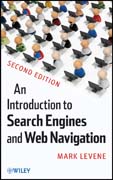
This book is a second edition, updated and expanded to explain the technologies that help us find information on the web. Search engines and web navigationtools have become ubiquitous in our day to day use of the web as an information source, a tool for commercial transactions and a social computing tool. Moreover, through the mobile web we have access to the web's services when we areon the move. This book demystifies the tools that we use when interacting with the web, and gives the reader a detailed overview of where we are and where we are going in terms of search engine and web navigation technologies. INDICE: Chapter 1 Introduction. 1.1 MEMS. 1.2 Coupled systems. 1.3 Required knowledge. 1.4 Dimensional analysis. Chapter 2 Microfabrication. 2.1 Bulk and surface micromachining. 2.2 Lithography . 2.3 Layer deposition. 2.4 Layer etching. 2.5 Fabrication process design. Chapter 3 Statics. 3.1 Static equilibrium. 3.2 Stress-strain relationship. 3.3 Thermal stress. 3.4 Beam behaviors subjected to torsional moment. 3.5 Moment-curvature relationship. 3.6 Beam equation. 3.7. Galerkin method. 3.8 Energy method. 3.9 Energy method for beam problems. Chapter 4 Static behaviors of microstructures. 4.1 Elements of microstructures. 4.2 Stiffness of commonly used beams. 4.3 Truss. 4.4 Stiffness transformation. 4.5 Static behavior of planar structures. 4.6. Residual stress. 4.7. Cubic force of structures. 4.8. Potential energy. 4.9. Analogy between potentialenergies. Chapter 5 Dynamics . 5.1 Cubic equation. 5.2 Description of motion.5.3 Governing equations of Dynamics. 5.4 Energy conversion between potential and kinetic energy. 5.5 Free vibration of undamped systems. 5.6 Vibration of damped systems. 5.7 Systems with multi-degree-of-systems. 5.8 Continuous systems. 5.9 Effective mass, damping and stiffness. 5.10 Systems with repeated structures. 5.11 Duffings equation. Chapter 6 Fluid dynamics. 6.1 Viscous flow. 6.2Continuity equation. 6.3 Navier-Stokes equation. 6.4 Reynolds equation. 6.5 Couette flow. 6.6 Stokes second problem or Oscillating plate in fluid. 6.7 Creeping flow. 6.8 Squeeze film. Chapter 7 Electromagnetics. 7.1 Basic elements ofelectric circuit. 7.2 Kirchhoff's circuit laws. 7.3 Electrostatics. 7.4 Forceand moment due to electric field. 7.5 Electrostatic forces and moments actingon various objects. 7.6 Electromagnetic force. 7.7 Force acting on moving charge in electric and magnetic fields. 7.8 Piezoresistance. 7.9 Piezoelectricity. Chapter 8 Actuators: piezoelectric and thermal actuators. 8.1 Composite beams. 8.2 Piezoelectric actuators. 8.3 Thermal actuators. Chapter 9 Actuators: electrostatic and electromagnetic actuators. 9.1 Electrostatic actuators. 9.2 Comb drive actuator. 9.3 Parallel plate actuator. 9.4 Torsional actuator. 9.5 Fixed-fixed beam actuator. 9.6 Cantilever beam actuator. 9.7 Dynamic response ofgap-closing actuators. 9.8 Approximation of gap-closing actuators. 9.9 Electromagnetic actuators. Chapter 10 Sensors. 10.1 Force and pressure sensors. 10.2Accelerometers. 10.3 Micromachined Accelerometers. 10.4 Electrostatic accelerometers. 10.5 Vibratory gyroscopes. 10.6 Other issues.
- ISBN: 978-0-470-52684-2
- Editorial: John Wiley & Sons
- Encuadernacion: Rústica
- Páginas: 478
- Fecha Publicación: 15/10/2010
- Nº Volúmenes: 1
- Idioma: Inglés
